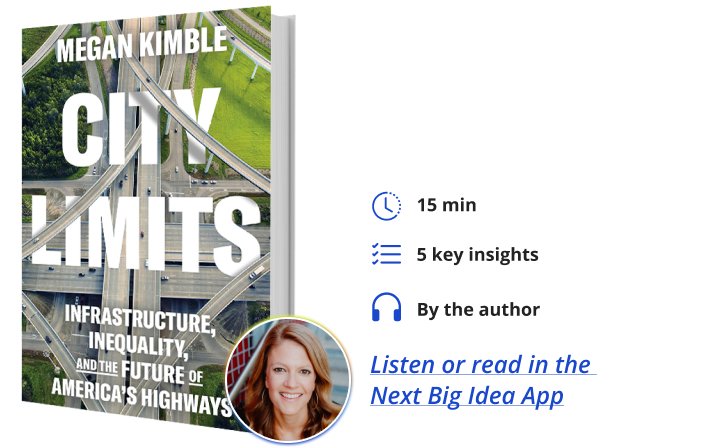Megan Kimble is an investigative journalist based in Austin, Texas, primarily covering housing and transportation. She writes narrative features for national and Texas publications, including the New York Times, Texas Monthly, and Bloomberg CityLab.
Below, Megan shares five key insights from her new book, City Limits: Infrastructure, Inequality, and the Future of America’s Highways. Listen to the audio version—read by Megan herself—in the Next Big Idea App.

1. Widening highways doesn’t fix traffic.
Every major American city has a highway tearing through its center. Seventy years ago, planners sold these highways as essential progress to our future prosperity. The automobile promised freedom, and highways were going to take us there. Instead, they divided cities, displaced people from their homes, chained us to our cars, and locked us into a high-emissions future. The more highways we built, the worse traffic got.
Widening the highways doesn’t help. This has been well understood since at least 1962, when an economist detailed how travel demand increased as road capacity was added. Transportation is a good, and like any other, it follows the laws of supply and demand. If you make it easier and cheaper for people to drive, more people will drive. This is known as induced demand.
Between 1993 and 2017, the hundred largest urbanized areas in the United States spent more than $500 billion adding new freeways or expanding existing ones. In those same cities, congestion increased by 144 percent, significantly outpacing population growth. And yet, across the country, state departments of transportation continue to spend billions of dollars to widen highways—promising to fix traffic.
That’s exactly what’s happening in Texas. The Texas Department of Transportation, or TxDOT, will spend more than $60 billion expanding highways in cities across the state. In early 2020, the state voted to allocate $4 billion to expand I-35 in Austin, a mile from where I live. Soon after, I learned about a $9 billion plan to expand I-45 in Houston and rebuild the entire downtown loop, including I-69 and I-10. This project will demolish 1,200 homes, displace 300 businesses, and consume more than 450 acres of land. “The effects of the project,” TxDOT concluded, “would be predominately borne by minority and low-income populations.”
There is increasing opposition to highway expansion—a modern freeway revolt. In Houston, a grassroots group called Stop TxDOT I-45 organized to try to stop the I-45 expansion. An emergency room nurse named Molly Cook started going door to door, asking residents if they’d heard about the expansion and how they felt about a highway coming closer to their neighborhood. People worried about flooding and displacement and often responded, perplexed, “That won’t even fix traffic.” Houston is home to the world’s most famous example of induced demand: the Katy Freeway. After TxDOT expanded the Katy Freeway to 26 lanes, making it one of the widest highways in the world, rush hour travel times increased by 33 percent. The highway got wider, and traffic got worse.
2. Highways should not have been built through the center of cities.
In 1956, President Dwight D. Eisenhower sold Congress on the Interstate Highway system as a way to build connections between cities for economic development and national defense. The program offered to pay 90 percent of the construction cost for these highways, with almost no strings attached.
Shortly after the Interstate Highway Act passed, Eisenhower appointed an old military buddy, General John S. Bragdon, to oversee the implantation of the program. By 1959, Bragdon found that the interstate program was running $11 billion over budget. This was largely because states were building urban highways directly through the center of cities. States were taking advantage of the liberal federal funding to address local traffic congestion. In part, this was motivated by a desire to clear blighted neighborhoods—neighborhoods that had been redlined and denied access to credit two decades earlier simply because Black, Hispanic, and immigrant families lived in them.
“More than a million people (mostly people of color) would eventually be forced from their homes for highway construction.”
Eisenhower asked Bragdon to investigate the matter. Did Congress intend for highways to be built through cities, or around them? Bragdon presented his findings to the president in April 1960:
“We do not believe that interstate highways should be directed towards the center of congestion, as is now the case. More emphatically, we do not believe that the Interstate System is the vehicle for solving rush-hour traffic problems, or for local bottlenecks. Practically all the experts on the transportation problems of cities agree that rapid transit and mass transit systems are the solution.”
Bragdon urged Eisenhower to direct the Bureau of Public Roads to revise its criteria—to focus on connections between cities rather than congestion within them. Eisenhower’s response to this presentation was captured in a memorandum published a few days later. Eisenhower responded, in frustration, that “the matter of running Interstate routes through the congested parts of the cities was entirely against his original concept and wishes; that he never anticipated that the program would turn out this way… those who had not advised him that such was being done, and those who had steered the program in such a direction, had not followed his wishes.”
But it was an election year. Funding had been committed. Eisenhower’s hands were tied. No direction would be given for the Bureau of Public Roads to change course. More than a million people (mostly people of color) would eventually be forced from their homes for highway construction.
In the book, I tell the stories of people like Modesti Cooper, a Black woman in her thirties who will lose her brand new home through eminent domain for the expansion of I-10. Modesti lives only two blocks from where O’Nari Guidry, a Black woman in her 70s, lost her family’s home when that same highway was constructed in the 1960s. These stories show that we have not heeded the lessons of the past, when highways demolished mostly Black and brown neighborhoods so that white people could get home faster.
3. Highways are fossil fuel infrastructure.
Today, transportation is the country’s leading contributor to greenhouse gas emissions. On-road emissions in Texas alone account for nearly half a percentage of total worldwide carbon dioxide emissions—more than some whole countries.
And yet, even as our cars have become more fuel efficient, emissions from passenger vehicles continue to climb. Why is that? Mostly because we are driving more frequently and farther as our cities sprawl and housing becomes increasingly unaffordable.
“Highway expansion only encourages more driving—generating more and more greenhouse gas emissions.”
Electric vehicles alone will not reverse this trend. To meet the carbon reduction targets set by the Intergovernmental Panel on Climate Change (IPCC), we need to put 70 million electric vehicles on the road in the next decade and reduce driving by 20 percent.
Highway expansion only encourages more driving—generating more and more greenhouse gas emissions. More than half of the $1.2 trillion enabled by the 2021 Infrastructure Investment and Jobs Act will be spent on highway expansion and resurfacing. Instead of spending billions to widen highways, we should invest federal money in transit systems.
4. Highways impoverish transit.
The reason public transit is slow and inefficient in most American cities is simple: You get what you pay for. We have never made the kind of investment in transit at the national level that we have in highways.
For fifty years, federal transportation funding has been allocated according to an 80-20 split. Eighty percent of federal money goes to highways and roads, and only 20 percent goes to transit. This ratio was agreed upon in 1982, under President Ronald Reagan, as an incentive for urban legislators to support an increase in the gas tax. This ratio has long since become obsolete. Today, we still spend four times as much on highways as on transit.
Transit makes cities more affordable: The average family in car-centric Houston spends more than 20 percent of their household income on transportation, compared to only 9 percent in New York City, where most people use transit. When you combine housing and transportation costs, Houston is nearly as expensive to live in as New York City. The research is clear: Car-centric cities are punishing for low-income families, for the simple reason that driving is expensive.
5. We should tear down urban highways.
Rochester, New York, did just that. The city removed part of its Inner Loop highway in 2017 and built affordable housing in its place. I visited Rochester, and the change is remarkable. The city replaced a sunk trench circling downtown with a two-lane city street lined with a bike lane and wide sidewalk. You can stand in the middle of this street, on land that used to be a highway, and look up at three and four-story apartment buildings constructed in its place.
Rochester is not alone. San Francisco, Portland, Milwaukee—all these cities have torn down urban highways. The corollary to induced demand—which says when you expand road capacity, people drive more—is reduced demand. A global study of more than a hundred projects that reduced road capacity found overall traffic reduced by 25 percent, even controlling for increased travel on parallel routes.
In Dallas, the Texas Department of Transportation considered removing a stretch of elevated highway on the eastern edge of downtown. A study found the highway negatively impacted nearly 400 acres of land in downtown Dallas, representing more than $9 billion in developable land, $255 million in property tax revenue for a city that desperately needs it, and the capacity for 26,000 housing units. Dedicating so much space to cars in our cities comes at an enormous cost.
I have only ever lived in cities that are completely wrapped in highways. They feel inevitably an immutable part of the urban landscape. Until I began investigating what cities looked like before highways were built—and what is possible when you remove them—it was hard to imagine what else might exist in their place. Highway removal transforms urban spaces and shows that another future is possible.
To listen to the audio version read by author Megan Kimble, download the Next Big Idea App today:






























